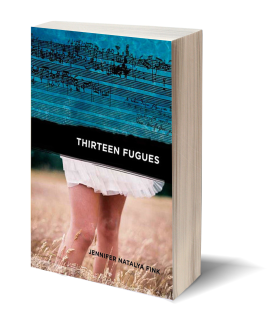|
 |
|---|
Reviewed by Laura Ender
It's difficult to define Thirteen Fugues. It might be an experimental novel or it might be a collection of stories; it morphs into poetry and then returns to prose. To define "fugue," however, you need only to turn to page one:
Fugue:
1. A musical composition in which one or more themes are introduced and then repeated in complex patterns.
2. A psychological condition characterized by a trance state and the assumption of a new identity, sometimes accompanied by a physical or psychological journey to a previous location.
These might be the only definitions you'll really need to read it. More than focusing on plot arcs or narrative, Thirteen Fugues zeroes in on its central character, Tanya Irene Schwartz, and her experience of the world. Nothing is simple or expected because
…fugues split hairs. There are real fugues and tonal fugues and endless arguments regarding which is which. The real fugues transpose invert repeat the same melodic structure; the tonal ones change the original melody in the process. Some argue tonal fugues are the true if not real fugues, since the complex transformations of melody through fugal response is precisely the point of the fugue in the first place.
In the case of Thirteen Fugues, it's a character rather than a melody being transformed: each section or story deals with Tanya at a different time in her life. Themes repeat and morph as Tanya grows—sexuality and eroticism, sisterhood, law and religion, death, patriotism—bleeding into each other until they form something new. Sometimes Tanya becomes a new person, as in "Bikini" and "Voluptuous Anguish," discovering and creating new versions of herself.
It's unclear at times what's real and what's imagined, especially when her sister, Jane, is involved—Fink does a wonderful job capturing the ecstatic confusion of childhood. In "World Records," we are introduced to Tanya and her sister Jane as they pore over the Guinness Book of World Records and Ripley's Believe It or Not!. What might seem like natural childhood curiosity is soon revealed to be more. Violence and sensuality run down the center of these girls' relationship. "She would skin easily," Tanya thinks as she digs her nails into her sister, "where they'd scratched messages to each other all summer, carving out their names in those smooth chalkboard flats just above the knee." Jane hurts Tanya and she welcomes it, longs to be in contact with her older sister even in the most gruesome of ways: "She imagines herself skinned and tanned and stretched around Jane like a shawl." Later, in "Vertebrae" and "Spitbugs," we see Tanya resist her sister's many excuses to touch her, but throughout the book she often revels in the attention, wanting to bond with her sister on the most intimate levels.
Tanya's relationship with Jane dominates about half of the book, but as Tanya gets older, her sexual energy finds other outlets. In "Plugged," her desire becomes frantic and the prose starts to break:
Plug me up plug me up words blurred against the whir of her
mouth and
winter starved trees rustle outside they
could be your morning breath, voice slow, gritty, the mac
truck passes (driver pumped up on grainy sugar sweet
cocaine, throat too dry to match that country
western radio as he pumps that gas pedal
hard down this house a blur running
tongue against parched lips leaning deeper
down into his custom-beaded seat
remembering the taste of those wrinkled
maps of veins behind your knees at dawn)
The prose gets frantic in other places, too, though it generally keeps its margins. In "Slipping," punctuation will disappear and syntax will tangle during moments of sexual fantasy, contrasting the reasonable prose surrounding the topics of Jewish law and the question: "Can women rape men?"
Thirteen Fugues deals with many questions and problems, but it doesn't pretend to provide answers. In the final section, "Thirteen Fugues," a tale is told of a man who was absorbed into a fugue state, believing for a period that he was another man entirely and developing a new life in that persona before snapping back to his old self and remembering none of it. This parallels a story about Jane's epileptic aspirations, and Tanya's own momentary fugue state during which she cannot remember her name. The man's case is studied but not solved. Jane is not epileptic, no matter how much she wants to be. But Tanya runs toward home, her name echoing as her feet pound against the pavement. All the struggles of the book have led here, to this quiet moment. There's no grand plot arc, no problems solved. There's just Tanya.
Remember that when you begin reading Thirteen Fugues. Don't expect it to be like anything you've ever read before. Surrender to the language, to the imagery, to the characters, and you will find yourself transported into your own fugue state, thinking and feeling differently than you have before.
